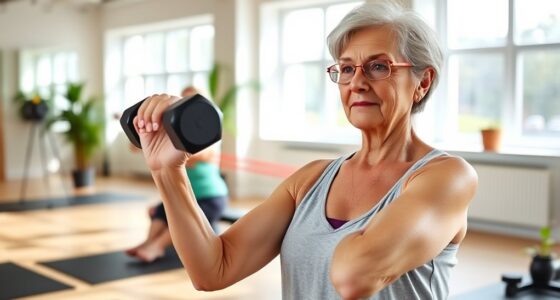Modified barre workouts for seniors focus on gentle movements that improve strength, flexibility, and balance while prioritizing safety. You’ll use sturdy chairs, resistance bands, and handrails to support your routine. Warm-ups prepare your muscles, and exercises are adjusted to reduce joint strain and avoid falls. Proper posture and gradual progress help you build confidence and strength. Keep exploring for tips on creating a safe, supportive environment that encourages your progress and well-being.
Key Takeaways
- Use sturdy chairs and handrails to provide additional support and stability during exercises.
- Modify movements to be slower, gentler, and focus on proper alignment to prevent strain and enhance safety.
- Incorporate lightweight resistance bands and low-impact movements to promote muscle engagement safely.
- Gradually increase exercise intensity and complexity, ensuring comfort and listening to individual body signals.
- Emphasize warm-up routines, breathing techniques, and posture correction to improve safety and effectiveness.
Understanding the Benefits of Barre for Older Adults
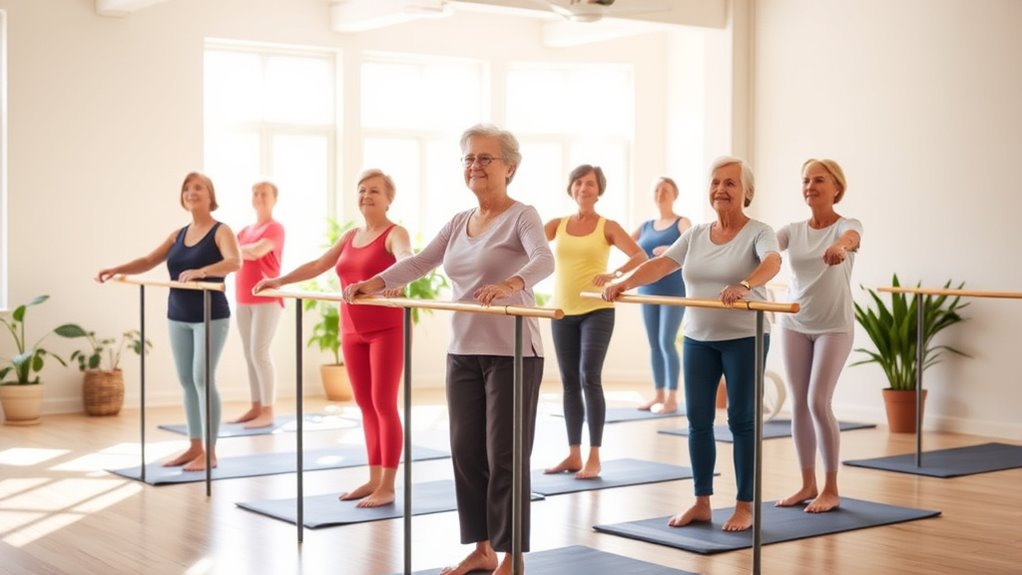
Although many people associate barre workouts with young dancers, they offer significant benefits for older adults as well. As you age, you might face age-related concerns like reduced strength, balance issues, and joint stiffness. Barre workouts help address these by improving muscle tone, flexibility, and stability. Additionally, participating in regular classes fosters social engagement, which boosts mental health and reduces feelings of isolation. The structured, supportive environment encourages consistent activity, making it easier to stay motivated. You’ll not only enhance physical health but also enjoy social interactions that keep you connected to others. Incorporating wall organization elements into your routine can further enhance your space and motivate ongoing activity. Overall, barre workouts provide a safe, enjoyable way to tackle age-related concerns while building a sense of community and well-being.
Key Safety Considerations for Senior Participants

To guarantee your safety during barre workouts, it’s essential to use equipment properly and avoid any misuse that could cause injury. You should also pay attention to your body’s signals and know your physical limits to prevent overexertion. Staying mindful of these safety tips helps you enjoy the benefits of barre while reducing the risk of accidents. Additionally, understanding your body’s limits and how to adapt exercises accordingly can help prevent strain or injury.
Proper Equipment Use
Using the right equipment correctly is essential for guaranteeing safety during barre workouts for seniors. Proper equipment use helps prevent injuries and maintains a safe class environment. Always check that your barre is stable and at the correct height, and use non-slip mats when needed. Ensure resistance bands are in good condition without tears or frays. Here’s a quick visual:
| Equipment | Proper Use |
|---|---|
| Barre | Securely anchored and at waist height for comfort |
| Resistance Bands | No tears, gentle resistance, and replace if worn |
| Non-slip Mats | Stable, clean, and free of wrinkles or debris |
Additionally, understanding the importance of equipment safety can help minimize risks and promote confidence during workouts.
Monitoring Physical Limits
Monitoring physical limits is essential to ensuring senior participants stay safe during barre workouts. You should pay close attention to posture correction and muscle engagement to prevent strain or injury. To do this effectively:
- Listen for signs of discomfort or fatigue and adjust exercises accordingly.
- Regularly check your posture, ensuring proper alignment to avoid unnecessary stress.
- Focus on controlled movements that promote muscle engagement without overexertion.
- Use mirrors or instructor feedback to maintain awareness of your body’s signals.
- Staying informed about AI safety measures can help trainers implement better practices for monitoring participants’ physical limits.
Essential Equipment and Modifications for Gentle Barre Workouts
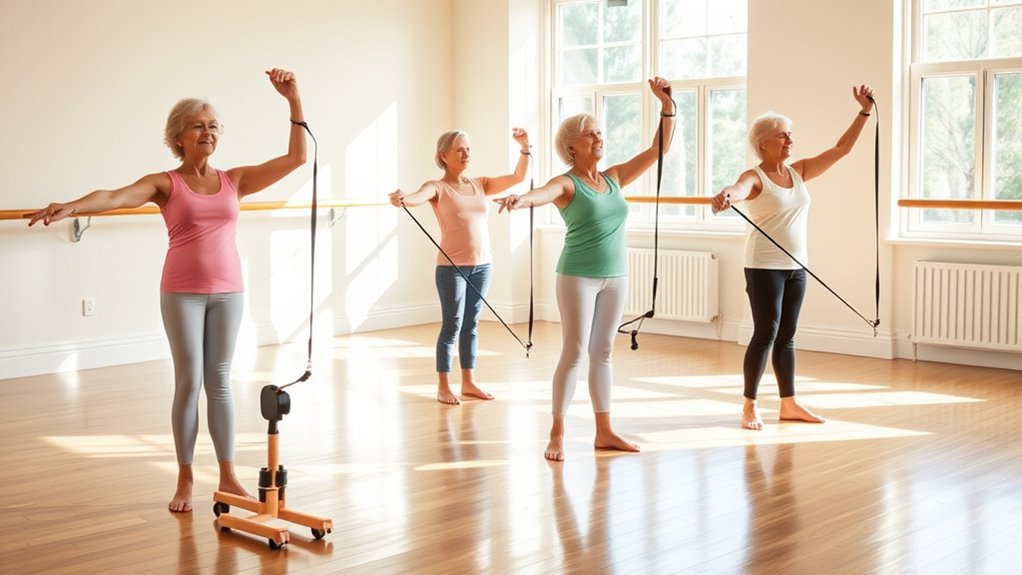
Gentle barre workouts for seniors require minimal but specific equipment to guarantee safety and effectiveness. A sturdy chair serves as an essential tool, helping you perform chair exercises that improve strength and stability. It also supports balance training, reducing the risk of falls. You might use a lightweight resistance band for gentle stretching and muscle activation, but keep it simple. The barre itself can be a fixed or portable handrail, providing stability during movements. Non-slip mats help prevent slips, especially on smooth floors. Adjustments like lowering the height of the barre or using additional support can make exercises more accessible. Focus on maintaining proper posture with these modifications, ensuring each movement is safe and effective for your fitness level. Incorporating sound healing techniques during warm-up or cool-down sessions can also enhance relaxation and mental focus.
Warm-Up Routines Tailored for Seniors
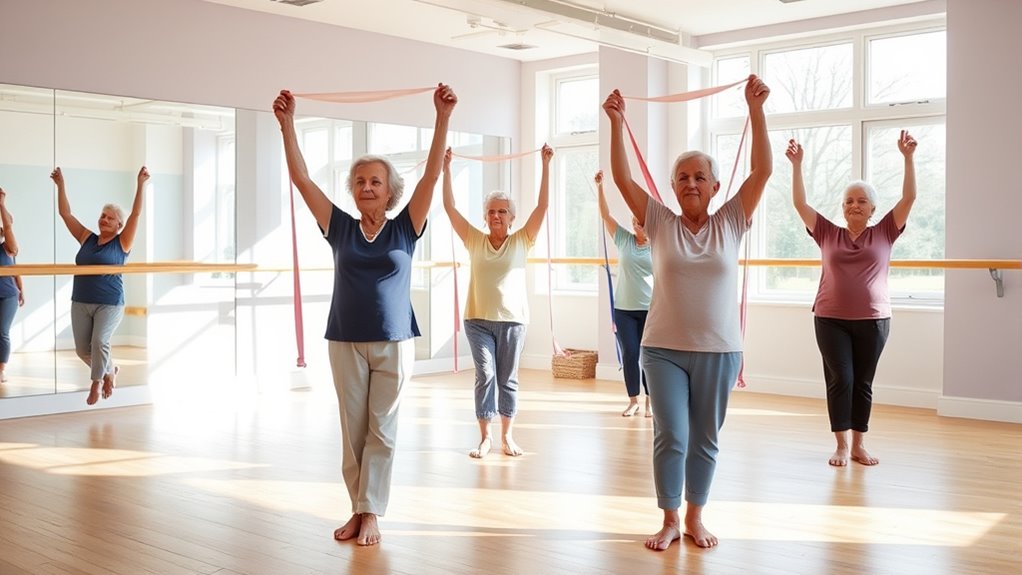
Start your warm-up with gentle stretching techniques to loosen up your muscles safely. Focus on breathing and relaxation exercises to help you stay calm and centered. Then, gradually increase your movements to prepare your body for the workout ahead. Incorporating mindfulness practices can enhance your overall sense of well-being and improve your workout experience.
Gentle Stretching Techniques
Since your muscles and joints may be more sensitive as you age, incorporating gentle stretching techniques into your warm-up routine helps prepare your body safely. Start with simple chair exercises to loosen tight muscles, such as seated leg lifts or arm stretches. Then, use dance-inspired movements like gentle torso twists and arm circles to increase circulation. Next, incorporate dynamic stretches like ankle rolls and shoulder shrugs to improve mobility. Finally, focus on slow, controlled movements that gently elongate your muscles, avoiding any bouncing or jerking. These techniques help improve flexibility and reduce injury risk. Remember, always listen to your body and avoid overstretching. Gentle stretching ensures your muscles are ready for the workout ahead, making your barre session both safe and effective.
Breathing and Relaxation Exercises
Breathing and relaxation exercises are essential components of a safe warm-up routine for seniors, helping to calm the mind and prepare the body for movement. By practicing simple meditation techniques, you can reduce stress and enhance focus before starting your workout. Deep, controlled breaths activate your parasympathetic nervous system, promoting relaxation. Incorporating these exercises improves stress management and eases muscle tension. Here’s a helpful table to guide your routine:
| Technique | Benefit |
|---|---|
| Deep diaphragmatic breathing | Reduces anxiety, increases oxygen flow |
| Mindful breathing | Enhances focus, promotes calmness |
| Slow inhalations/exhalations | Lowers heart rate, relaxes muscles |
| Progressive muscle relaxation | Eases tension in targeted areas |
| Guided visualization | Encourages mental clarity and serenity |
Engaging in these mindfulness practices can also foster a sense of mindfulness and presence that supports overall well-being.
Gradual Movement Progression
To guarantee a safe and effective warm-up, gradually increasing movement intensity helps you prepare your muscles and joints for more active exercises. This progression supports posture correction and assures your body moves comfortably. Start with gentle stretches, focusing on alignment. Then, follow these steps:
- Begin with slow, controlled arm and leg lifts to activate muscles.
- Incorporate light balance exercises to improve stability.
- Do simple posture correction moves to correct alignment before more vigorous activity.
- Check equipment maintenance; ensure the barre is secure and supports proper form.
- Incorporate creative techniques to make warm-up routines engaging and stimulating for seniors.
This gradual approach minimizes injury risk and boosts confidence for more challenging exercises. Remember, warming up properly is key to enjoying your workout safely and effectively.
Adapted Barre Exercises to Improve Strength and Flexibility

Adapting barre exercises for seniors involves modifying traditional moves to prioritize safety and effectiveness. Chair adaptations are a key component, providing support and stability during workouts. Using a sturdy chair, you can perform chair-assisted exercises that target major muscle groups, helping to build strength and improve flexibility. These modifications allow you to focus on proper form without risking balance or falls. For example, you might do leg lifts while holding onto the chair or stretch your arms and shoulders with chair support. This approach makes exercises accessible and reduces strain on joints. By incorporating chair adaptations, you can gradually enhance your muscular endurance and flexibility while feeling secure and confident throughout your workout. Additionally, utilizing portable exercise equipment can further assist in adapting routines to individual needs, ensuring a safe and effective workout experience.
Incorporating Balance and Stability Into Barre Sessions
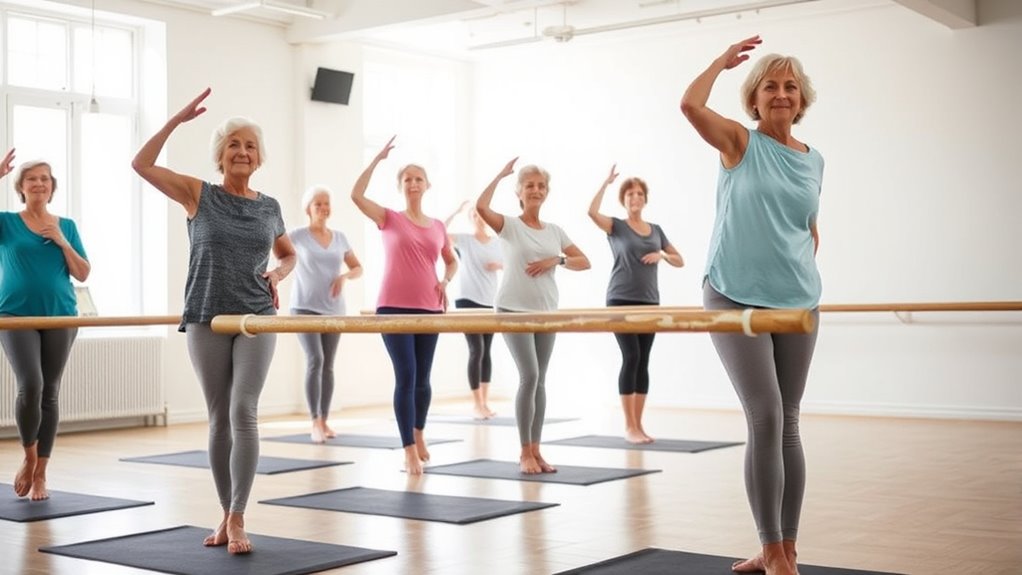
Incorporating balance and stability into your barre sessions is essential for safe and effective workouts, especially for seniors. Balance enhancement helps prevent falls, while stability training improves functional movement. To achieve this, try:
- Engaging in single-leg exercises to challenge your stability.
- Incorporating slow, controlled movements to focus on balance cues.
- Using the barre for support during balance drills, gradually reducing reliance.
- Adding gentle core strengthening to improve overall stability.
- Exploring best workout practices to optimize your exercise routine and prevent injury.
These strategies help strengthen muscles that support your joints and enhance proprioception. Consistent practice with balance and stability training not only boosts confidence but also promotes independence. Remember, gradual progression is key—listen to your body and adjust exercises accordingly for ideal safety and results.
Tips for Proper Posture and Alignment in Modified Movements

Maintaining proper posture and alignment is crucial when performing modified movements to guarantee safety and maximize benefits. Focus on posture correction by keeping your shoulders relaxed and down, avoiding hunching or shrugging. Use alignment cues such as engaging your core to support your spine and prevent overextension. Keep your hips level and knees aligned with your toes during leg movements. Throughout the workout, constantly check your stance, ensuring your head is in line with your spine, avoiding forward head posture. Pay attention to how your body feels—if you notice discomfort or strain, adjust your position accordingly. Remember, precise alignment promotes better muscle engagement and reduces injury risk, helping you get the most out of your modified barre exercises while keeping your body safe and comfortable.
Creating a Supportive Environment for Senior Barre Classes
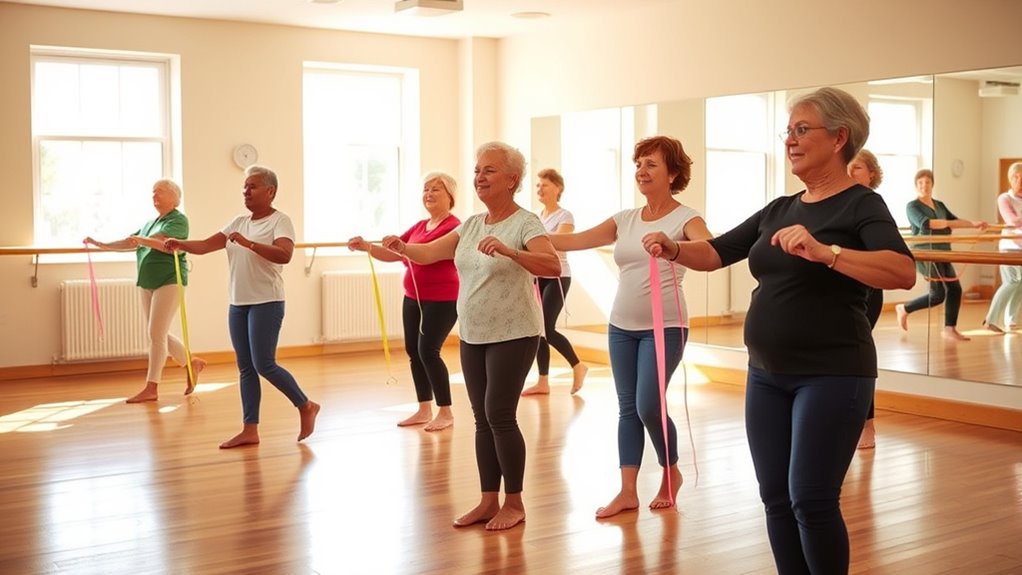
Creating a supportive environment for senior barre classes starts with fostering a space where participants feel comfortable, confident, and encouraged. To do this, focus on:
Foster comfort and confidence in senior barre classes through support, encouragement, and gentle guidance.
- Using adaptive equipment like sturdy chairs, resistance bands, or handrails to accommodate different mobility levels.
- Encouraging community engagement by promoting interaction and shared experiences among participants.
- Maintaining an inviting atmosphere that celebrates progress, no matter how small.
- Providing clear, gentle instructions that respect individual limits while motivating growth.
Progressing Safely and Recognizing Limits
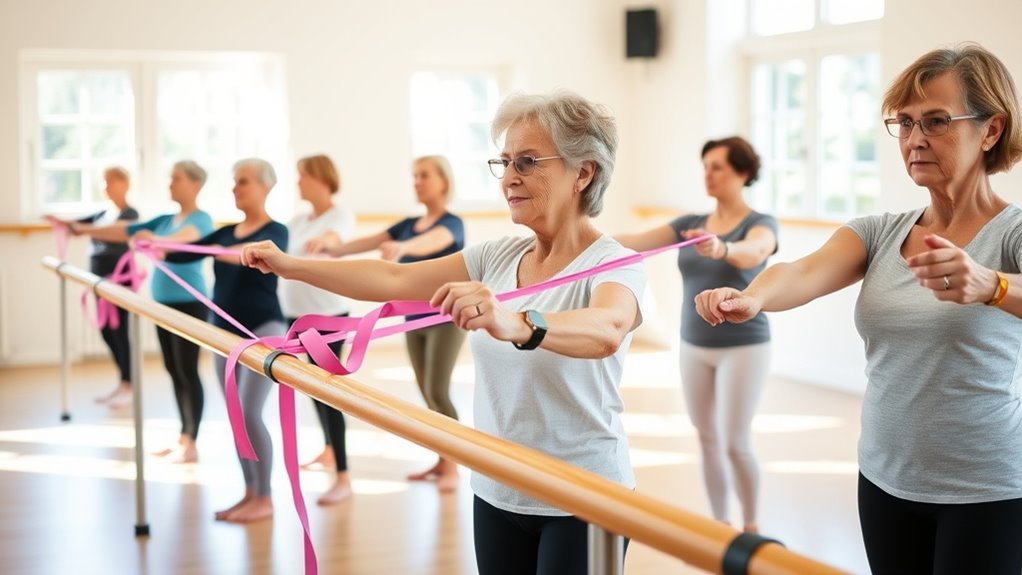
To progress safely, pay close attention to how your body feels during each workout. Increase intensity gradually to avoid strain, and don’t hesitate to modify movements to suit your comfort level. Listening to your body helps you recognize your limits and stay injury-free while improving strength.
Listening to Your Body
Listening to your body is essential for progressing safely during your barre workouts. Pay attention to how your joints feel, especially regarding flexibility, and how your muscles engage during each movement. Here are four tips to help you stay in tune:
- Notice any joint stiffness or discomfort and adjust your range of motion accordingly.
- Feel for proper muscle engagement without overexerting or risking strain.
- Rest if you experience pain or fatigue, and avoid pushing through discomfort.
- Use your breath to gauge effort levels and prevent overexertion.
Gradual Intensity Increase
As you progress in your barre workouts, gradually increasing the intensity guarantees safe and effective improvement. Start with foundational movements, then slowly introduce advanced techniques and high-intensity routines as your strength grows. Recognizing your limits prevents injury and builds confidence.
| Level | Focus | Tips |
|---|---|---|
| Beginner | Basic poses and slow pace | Master form before increasing pace |
| Intermediate | Slightly faster tempo, added reps | Listen to your body, don’t push too hard |
| Advanced | High intensity routines, complex moves | Progress gradually, prioritize safety |
Modifying Movements Safely
Modifying movements safely is essential for preventing injuries and ensuring steady progress in your barre workouts. To do this effectively, you should:
- Start with basic movements before attempting advanced techniques, building strength gradually.
- Use equipment customization, like adjustable bars or supportive props, to match your comfort level.
- Listen to your body—if a movement causes pain or discomfort, adjust or skip it.
- Focus on proper form over range of motion, recognizing your limits and avoiding overexertion.
Resources and Guidance for Seniors Starting Barre Workouts
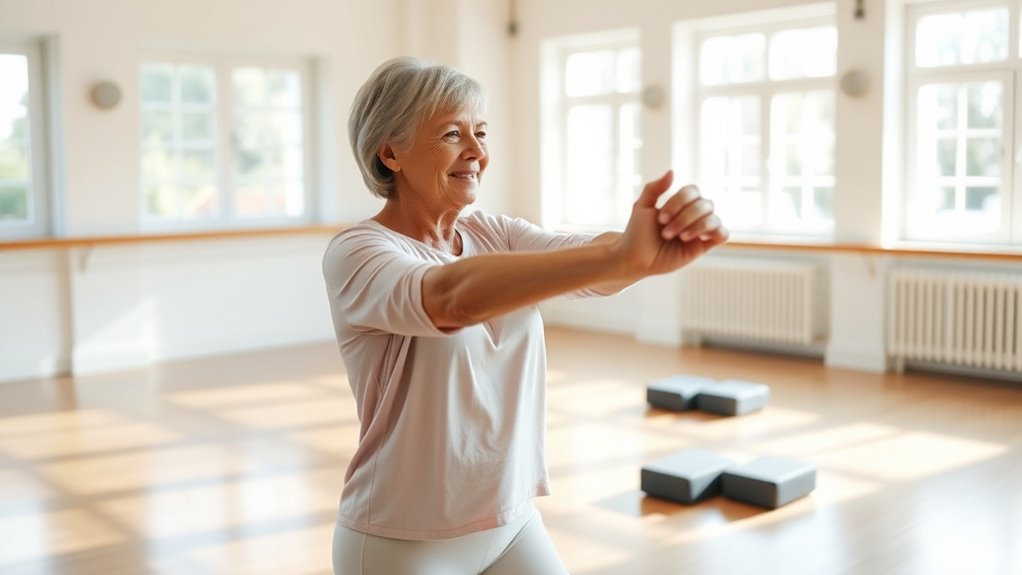
Are you unsure where to find the right resources or guidance to begin barre workouts safely? Start by exploring local community centers or senior fitness programs that offer beginner classes. Look for instructors experienced in working with seniors, who can adapt movements to your needs. Consider trying chair yoga or aquatic therapy as gentle, supportive options to build strength and flexibility before advancing to full barre routines. These resources help you develop core stability and balance, easing the progression into more active workouts. Online platforms also provide tutorials and virtual classes designed for seniors. Always consult your healthcare provider before starting a new exercise routine. With the right guidance and supportive resources, you can confidently begin your barre journey safely and effectively.
Frequently Asked Questions
How Often Should Seniors Participate in Barre Classes for Optimal Benefits?
You should aim for exercise frequency that balances activity and recovery. For ideal benefits, participate in barre classes 2 to 3 times a week. Regular class participation helps improve strength, balance, and flexibility without overtaxing your body. Listen to your body and adjust your schedule as needed. Consistency is key, so find a routine that fits your lifestyle and keeps you motivated while allowing time for rest and recovery.
Are There Specific Contraindications for Seniors With Joint Issues?
If you’re considering activities with joint restrictions, it’s important to consult your doctor first. Be aware of any medication interactions that might affect your ability to exercise safely. You should avoid high-impact or strenuous movements that could aggravate your joint issues. Instead, opt for gentle, low-impact exercises, and listen to your body. Always follow professional advice to make sure your workouts support your health without risking injury.
Can Seniors With Osteoporosis Safely Do Barre Exercises?
Did you know that osteoporosis affects about 1 in 3 women over 50? If you’re considering barre exercises, it’s crucial to follow osteoporosis precautions. Seniors can safely do barre workouts with modifications, focusing on balance improvements and avoiding high-impact moves. Always consult your healthcare provider first, and work with a trained instructor who understands your needs. Properly adapted, barre can boost strength and stability safely.
How Can Caregivers Support Seniors During Barre Workouts?
You can support seniors during barre workouts by offering motivational encouragement to boost their confidence. Use adaptive equipment like chair supports or resistance bands to help them feel secure and comfortable. Remind them to listen to their bodies and take breaks when needed. Your positive attitude and gentle guidance will help seniors stay engaged and safe, making their experience enjoyable and empowering.
What Signs Indicate a Senior Should Stop or Modify an Exercise?
Imagine your grandma starts feeling dizzy or unsteady during exercise—that’s a clear sign she should stop or modify. You should watch for balance concerns, fatigue signals, or discomfort. If she feels pain, shortness of breath, or excessive fatigue, it’s time to pause. Always prioritize safety, and encourage her to communicate how she feels. These signs help prevent falls and make sure she exercises safely.
Conclusion
By blending balance, bravery, and gentle movements, you’ll build strength and boost confidence with modified barre workouts. Embrace everyday exercises that empower your body, encourage enjoyment, and enhance endurance. Remember, progress is personal, patience is key, and safety always comes first. So step into this supportive space, stay steady, and savor the strength and serenity that come from consistent, caring movement designed just for you. Your journey to joyful, rejuvenating fitness begins today!



